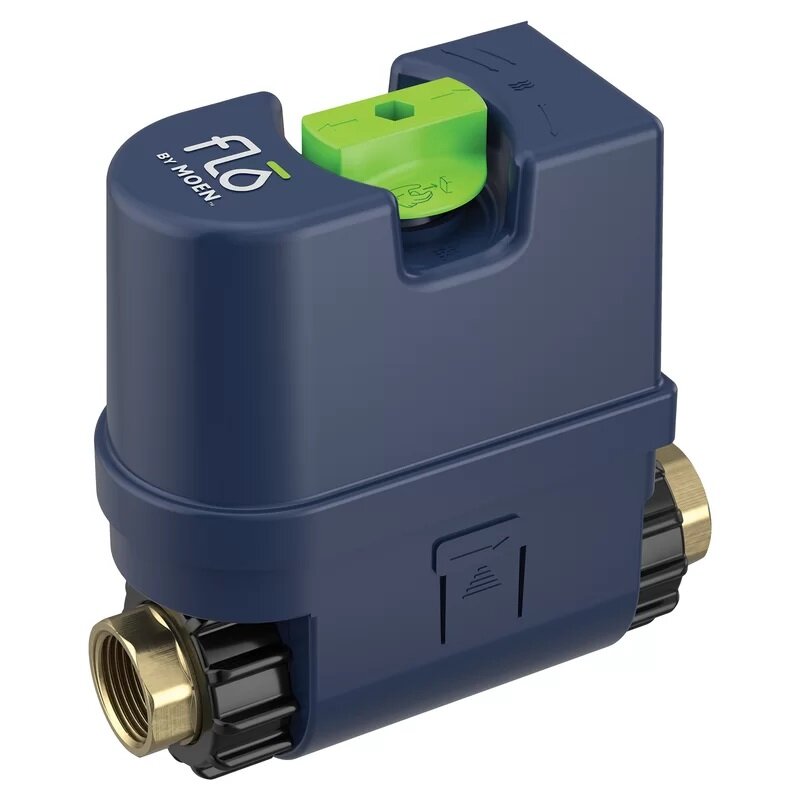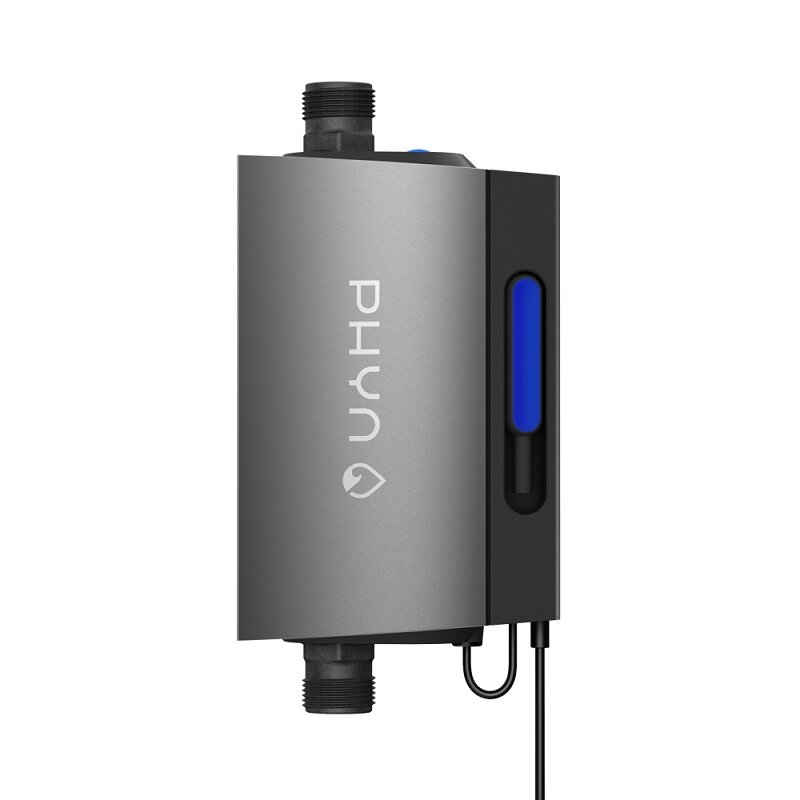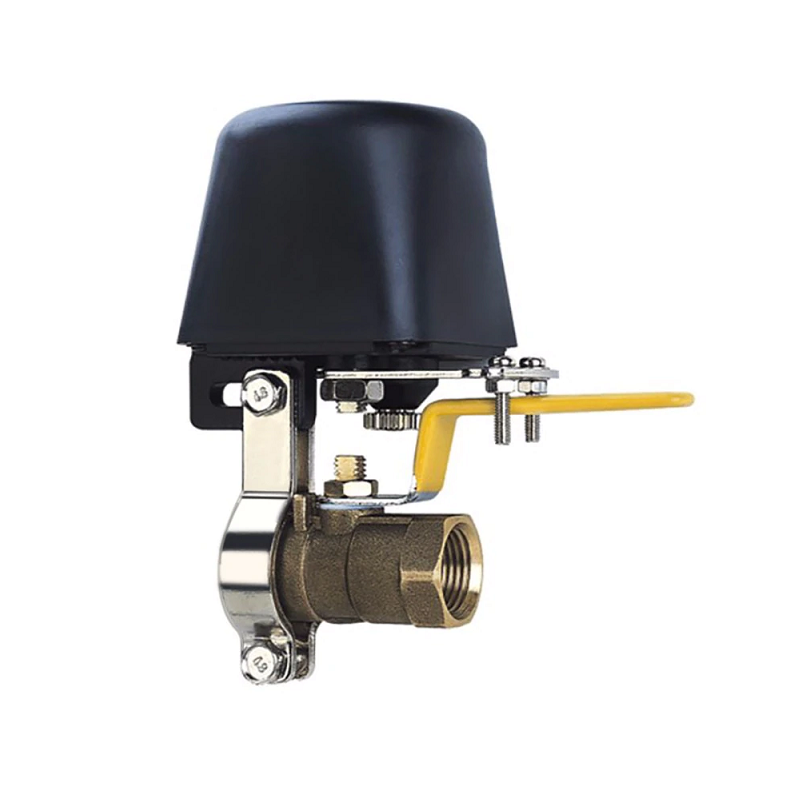Smart Water Shutoff Valves That Protect Your Home From Leaks
When you buy through links in this article, I may earn an affiliate commission. Learn More.
There are lots of smart water leak and flood sensors available now that can be connected to your smart home. These devices will quickly and accurately alert you to any potentially damaging water leaks but fall short in two key ways; they can’t do anything about the leak, and they only monitor a specific area where they are placed.
For a truly smart home response, we need a system that can intelligently take action when a leak is detected, and that’s where automatic water shut off valves come in. When my dishwater inlet valve cracked and started leaking into my kitchen cabinets I didn’t know anything about it until the floor on the other side of the wall became squishy.
Thankfully it was a slow leak and I was able to get things dried out, but it could have been disastrous. Since then, I’ve looked at getting some wireless water shut off valve in place to prevent it happening again, or at least warn me something is up before it gets that far.
I’ve spent around 40 hours researching the various products on the market. I’ve found that the Flo by Moen is the best overall Wi-Fi water shutoff valve. Moen is a maker of premium plumbing products and, while they may be pricey, their Flo system offers the most comprehensive automatic protection on the market.
I’ve also found some good alternatives for both in-line and add-on tap controllers, but these products tend to fall short in various ways. In addition, I’ve found that Z-Wave is a popular alternative communication technology for water valves in particular, so I’ve included options for those in the list as well. See my Z-Wave controller recommendations if you’d like to explore that option.

Flo by Moen
The premier smart water cutoff valve, the Flo works by monitoring flow rates coming into your home and comparing it to the 'normal' patterns it learns over time. Any abnomal increase and it alerts you and cuts the supply to prevent water damage from leaks.
- Fits 3/4” to 1-1/4” pipe
- WiFi, no hub required
- Alexa and Google Home support
- Internal leak detection
- Optional battery backup
- Indoor rates at IPX5
Types of Smart Water Shut Off Valves
Inline smart water shutoff valves
Arguably the best approach is that taken by inline smart water shut off systems. These are installed into the main water line into the house and usually include some sort of water flow monitoring and leak detection technology. They can respond on their own to automatically shut off the water supply with no dependence on anything else.
These systems have the key advantage of offering whole-home protection, in that they can detect a leak anywhere in the house pipework and shut off the water to all of it. This covers you not only for faulty appliances and taps but burst pipes and leaks in other unexpected places. As a bonus they can also track water usage and provide reporting in their relevant app.
The downside is you really should have these professionally installed as you’re dealing with the main inlet line, and they can be quite expensive devices as well.
Add-on smart valve controllers
The cheaper, simpler approach is to use a simple valve controller to shut off the water supply. These devices sit on top of an existing quarter-turn ball valve and can physically turn the lever for you by remote control. This obviously avoids the need for pipe cutting or plumbers.
They are dumber in that they just do the on/off part and rely on connected leak detectors of some kind to alert the system to a leak. While you can typically have many such leak detectors, you’re still limited to responding to leaks in monitored locations, and a burst pipe in the ceiling or floor is unlikely to get noticed for some time.
This approach is not all bad though, as it provides less ambiguity as to when the water should be turned off. The leak detectors are accurate and that means the valve can be shut off in seconds without the system worrying about whether it’s normal usage or not, or shutting things off when you don’t want it to.
Best In-Line Wi-Fi Shutoff Valve Overall
Flo by Moen
★★★★✩
✔ Fits 3/4” to 1-1/4” pipe
✔ Wi-Fi, no hub required
✔ Supports Alexa and Google Assistant
✔ Internal water leak detector
✔ Optional battery backup
✔ Outdoor rated (IPX5)
✘ Very expensive
✘ Requires power outlet (25’ extension optional)
✘ Subscription required for detailed reports
✘ Internet required for app control
What I Like
After a lot of consideration, I’ve given the best overall WiFi water shut off valve to Moen’s Flo system. It simply offers the most complete package with a good range of pipe sizes, smart home platform support for Alexa and Google Assistant with no hub requirements, battery backup, and outdoor capability. This also works with Ring Alarm which is a great addition for automated security responses to detected leaks.
It has automatic water leak detection built in, but also includes the option to use Moen’s leak sensors for extra protection and reliability. The automatic sensors monitor your water usage and try to detect unusual water flow that would indicate a problem. Other sensors are included to monitor for extremes of temperature and humidity in order to alert you to freezing risk.
This offers the advantage of being able to identify even slow leaks in toilets or hidden pipes that might otherwise go unnoticed for long periods, and presents it in a slick modern smart phone app with easy-to-use controls and event logging. You’ll also get very detailed and accurate reporting and analytics, but that comes with a catch.
Potential Concerns
That catch is that to get more than basic data reporting you’ll need to pay Moen’s monthly subscription. It’s not huge, but some people understandably see this as a cash grab given it’s an expensive piece of hardware already. Even so, Moen do throw in a deductible payment if you have an insurable incident, and an extended warranty for that extra fee.
A common concern with these inline water shut off valve types is their tendency for false positives. Like other models, the Flo uses pressure and flow rate sensing to ‘learn’ the normal usage patterns of your home’s water supply, and then alerts when something seems abnormal. Moen doesn’t offer any way to help this learning process, so you have to trust that it figures it out right, which it sometimes doesn’t, leaving you high and dry until you manually turn it back on.
Given we’re taking about your water pipes here, this is most likely a case of ‘better safe than sorry’ and the occasional inconvenience is likely worthwhile.
Alternative In-Line Wi-Fi Shutoff Valves
Phyn Plus
★★★★✩
✔ Fits 3/4” to 1-1/4” pipe
✔ WiFi, no hub required
✔ Supports Alexa
✔ Internal water leak detector
✔ Outdoor rated
✘ 110V/220V power required
✘ Plastic fittings
✘ Internet required for app control
What I Like
The Phyn Plus is a slick looking automatic water shutoff valve, but more importantly it’s outdoor rated, which makes it worth a look if you need that. It can also handle a 220V outlet, which gives it a bit more flexibility.
Like the Moen it includes pressure/flow sensors and a learning system to detect leaks. Unlike the Moen Flo it does occasionally check with you if it’s correct with it’s assumption, and allows you to override. This could result in it better handling potential water leaks automatically without causing some household angst.
Potential Concerns
The additional user input to the learning system is welcome, but it still suffers from issues around false positives as with other flow based detection systems.
I’m also not a fan of it having plastic fittings on such an expensive device. These are so easy to damage during install if you’re not careful.
It’s also been noted that while it does have a manual override in the event of a power failure (there’s no backup battery here), it requires a fiddly insertion of a specific screw driver. This can be awkward to get to, and to get traction on the screw to turn it.
Grohe Sense Guard
★★★✩✩
✔ Fits 3/4” pipe (1” adapter available)
✔ WiFi, no hub required
✔ Internal water leak detector
✘ 110V power only (27’ extension optional)
✘ Indoor use only
✘ Internet required for app control
✘ No smart home integration
What I Like
The Grohe Sense Guard is a smart looking automatic water shut off valve with very clear status indication via the ring light around the top edge, and simple manual controls in clear view. You do get whole home protection, and it’s WiFi connected, so no extra hardware is needed.
It’s a quality device, with good fittings for the price.
Potential Concerns
There’s no smart home integration, so you’ll be using only the dedicated smartphone app for control and alerts. That would usually put a device out of the running for me, but as it still offers remote app control I’ve chosen to include it for those who aren’t so interested in an integrated solution.
You’ll also need to check your pipe size as the Grohe doesn’t support many options, just the 3/4” and a possible 1” adapter.
Best Wi-Fi Add-on Valve Controller
Owlfeel Smart Water Valve
★★★★✩
✔ Fits 1/2” to 1-1/4” pipe
✔ Tuya based (supports Alexa and Google)
✔ WiFi, no hub
✔ 12V DC 1.5A barrel plug
✘ Weak motor
✘ No built-in sensors
What I Like
I previously recommended the Guardian Leak Prevention System as the better option, but it turns out these have not lasted the test of time and have been failing pretty regularly. Feel free to check it out for yourself, though. As such, there aren’t a lot of options when it comes to Wi-Fi connected add-on valves but for a number of low-cost offerings like this one. The Owlfeel Water Valve is one of numerous, largely identical, generic automatic water shut off valves that are sold under various brand names.
They’re cheap, fit a variety of existing ball valves, and operate through the widely used Tuya smart home platform. Through Tuya you’ll get some degree of Alexa and Google integration, but it’s not going to be a lot.
Being simple Wi-Fi and offering a cable ending in a barrel plug you’ll be able to use these anywhere in the world with a suitable AC/DC power pack. It comes with a US style one, but it’s easily swapped out for another format.
Potential Concerns
Being a cheap product from an otherwise no-name brand you shouldn’t expect anything in the way of support. You’ll also not get a best of breed product, with customers noting the motor is pretty weak, and the clamp is also a bit simplistic and may not hold well depending on your install situation. At least it clamps to the valve instead of the pipe.
Best Z-Wave In-line Water Valve

Leak Gopher by Leak Intel
★★★★★
✔ Fits 3/4” to 2” pipe (different models)
✔ Z-Wave Plus - controller required
✔ 10 year warranty
✘ 110v power required
✘ Indoor rated only
✘ No built-in sensors
What I Like
If you’re after something to use with a Z-Wave system, the Leak Gopher is your best bet for an inline install. It’s reasonably solid with a strong motor and a 10-year warranty. Again, as it’s just the water shut off valve, you’ll need some leak sensors connected to your Z-Wave system to trigger it.
While not WiFi and requiring additional infrastructure, Z-Wave still provides a wireless water shut off solution that offers some advantages over WiFi based models.
Potential Concerns
No whole-home protection here either, and some of the included valves have had poorly cut thread on the pipe connectors leading to some installs being more difficult than they should have been. It’s also quite pricey for what you get, but there aren’t many Z-Wave options in the inline category.
Best Z-Wave Add-on Valve Controller
Zooz Titan Water Actuator
✔ Fits 1/2” to 1-1/4” pipe
✔ Z-Wave Plus 700 - controller required
✔ Works with Ring
✔ Low wall clearance required (1”)
✔ 5-year warranty available.
✔ Any 12V 1A power supply
✔ Outdoor rated to IP66
✔ Wired leak probe included with 85bD alarm
✘ No built-in sensors
What I Like
This new product from Z-wave brand Zooz offers a compelling alternative. Using a dual clamp design ensures very strong leverage allowing it to handle pretty much any ball valve that fits. It even self-calibrates the required force for your particular valve with use. I like that the clamp system provides no-tool installation, just tighten the thumb screws by hand and you’re done.
It uses the newer Z-Wave 700 chipset for enhanced security, which allows it to work natively with a variety of other ecosystem including Ring, Hubitat, SmartThings, Alarm.com, and Home Assistant, and can be paired with Zooz leak sensors (or other Z-Wave leak sensors compatible with your hub).
It’s also refreshing that Zooz offers a 5-year extended warranty on this model once it’s registered, a rare level of confidence in a product in this category.
Potential Concerns
The biggest drawback, with this model is that it’s only available for US Z-Wave frequencies, even though you could use a localized power supply. Many Z-Wave hubs allow you to select which band to use, so you could potentially use this outside the US, but doing so may well be illegal is the US band is outside your countries approved ISM frequencies.
Alternative Z-Wave Add-on Valve Controller
EcoNet Bulldog valve robot
★★★★★
✔ Fits 1/2” to 1-1/2” pipe
✔ Z-Wave Plus - controller required
✔ High torque motor
✘ 110v power required
✘ Indoor rated only
✘ No built-in sensors
What I Like
I’ve given the EcoNet Bulldog Valve Robot the top spot in the add-on valve controller category primarily because it is a well built device that will get the job done with the most powerful motor on the market, so it should be able to handle your water supply via your existing levered ball valve.
It’s exclusively Z-Wave controller, but uses the newer Plus standard for added security and reliability, and that also means you can create deeper integrations with your other smart home devices if you use that protocol.
EcoNet says it is rain resistant, but they recommend protecting it nonetheless. You'll also note the mounting bracket is around the valve body, not the neighboring pipe like other models. This is preferable as it eliminates undue stress on the pipe joints when the motor is operating.
Potential Concerns
The biggest issue with this one is that it’s only suitable for North America. This is due to the different radio frequencies used for Z-Wave around the world.
Frequently Asked Questions
What is a WiFi water shut off valve?
All homes have a main shut off valve that can isolate the house from the water supply. A smart water shut off valve combines some sort of sensors to detect potential leaks and allow a motorized valve to automatically shut that supply on it’s own.
The term ‘wifi’ in this case refers to general wireless communication, which could be conventional WiFi or another radio protocol such as Z-Wave. It simply refers to the device being wireless and not requiring any sort of signal cabling.
These devices can provide valuable protection from major or minor water leaks in less visible places, or when you are out of the house and unable to respond to an emergency.
Some systems use flow and pressure sensors to try and guess ‘abnormal’ water use, while others use a number of individual leak detectors that can be placed in areas of concern, such as the laundry, basement, kitchen, etc.
Are wireless water shut off valves worth it?
Yes. 37% of US homes have suffered water damage, with an average insurance claim of over $6000. 14,000 people every day suffer a water emergency, and that’s just the serious ones. Even if you don’t suffer a damaging event, leaks from US households are common, and 10% of homes leak over 90 gallons a day. Freezing temperatures causing pipe bursts, corrosion, and valve wear can easily end in an unexpected water leak.
That adds up to a lot of wasted water consumption, and money. Even the highest priced automatic shut off valves will pay for themselves fairly quickly, and you may even get a discount from your insurance company for having one installed.
You can get some peace of mind from smart water leak detectors, but these will only tell you there is a leak. You’ll have to be in a position to stop it yourself, and that’s not always possible in time.
How much does it cost to install an automatic water shut off valve?
Wireless water shut off valves can vary significantly in price, from around $50 all the way up to nearly $1000. On top of that, you may need to pay a plumber to install it if you got for an inline model that can protect the whole home. It’s not usually a big job, so you’re probably looking at an additional $100-$200.
What happens if your internet is down?
Wi-Fi based smart valves will typically rely on the company’s servers for remote control via their app. This is not ideal as you are dependent on a third party for your product to work properly, or at all. Thankfully the basic shut off functionality of all of the valves in this list will still work if your WiFi is down, but you won’t have manual control via the app, or any alerting notifications.
Valves that use a dedicated smart home communications protocol, like ZigBee or Z-Wave, will fare better as they communicate directly with your smart home hub and any sensors you may have connected to it. These systems provide ‘local control’, which means they don’t need the internet at all to function. You will still lose alerting notifications when you’re away from home if your internet is down, as they still need a way to get that data to your phone.












